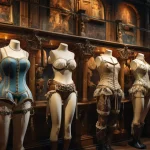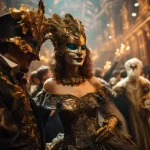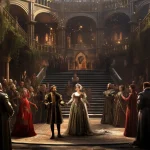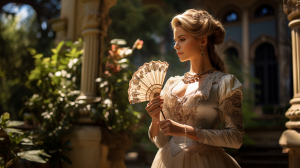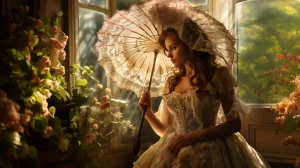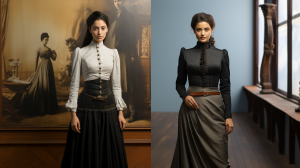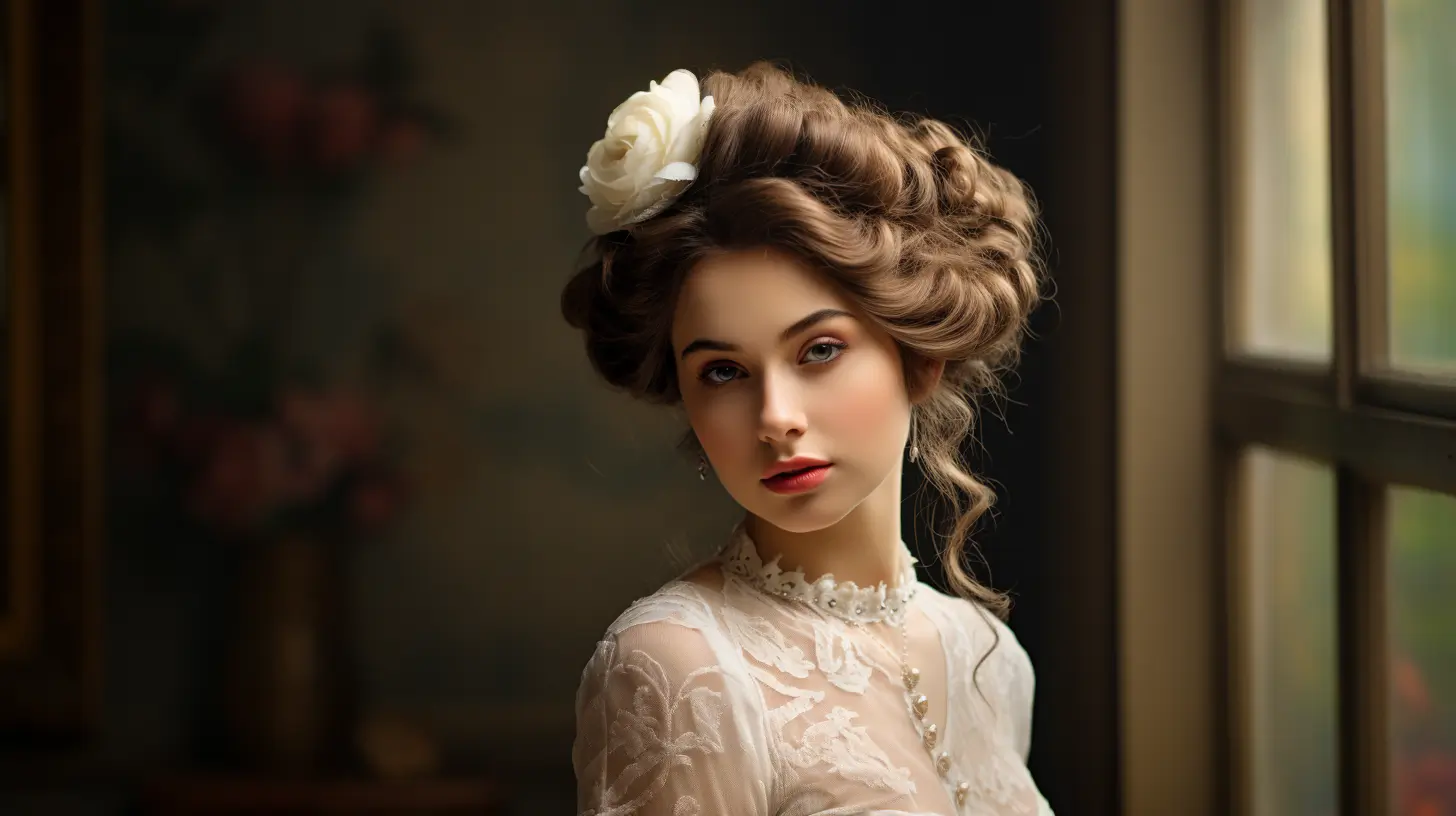
Elegance and Intricacy: Hairstyles of the Victorian Era Explored
Imagine strolling down a cobblestone street, the misty London fog curling around the hem of your coat. You’re not just walking through a city; you’re traversing a living, breathing canvas of fashion history. The Victorian era – a time when style wasn’t just about what you wore but how you wore it, with every curl of hair and placement of a pin speaking volumes. Here, in this world of corsets and top hats, hairstyles weren’t merely a part of one’s appearance; they were masterpieces perched atop the heads of women who navigated a society rife with unspoken rules and hidden meanings.
In the Victorian era, hairstyles were more than just a fashion statement; they were a language, a subtle dialect in the conversation of status, femininity, and artistry. This was a time when a hairstyle could dictate your place in society, and a bonnet wasn’t just a piece of cloth but a declaration of one’s standing. Women’s tresses were sculpted with the precision of a painter, each curl and braid a stroke of genius held in place by the unsung heroes of the time: hairpins.
As we delve into the world of Victorian Hairstyles, we’re not just exploring hair. We’re untying the ribbons of history to reveal stories woven through strands of hair, stories of women who spoke through the swoop of a bun or the tilt of a bonnet. So, let’s embark on this journey, not as mere observers but as time travelers, ready to unravel the elegance and intricacy of hairstyles that defined an era. Hold onto your hairpins; it’s going to be a fascinating ride.
Historical Context of Victorian Fashion
In order to fully grasp the significance of Victorian Hairstyles, we need to take a step back and immerse ourselves in the fabric of the Victorian era itself – a period teeming with contradictions and complexities. It was a time marked by rapid industrial progress, yet bound by stringent social norms. Fashion in the Victorian era was not merely a matter of choice; it was a display of one’s place in the rigid hierarchy of society.
Victorian fashion was a tangible expression of the era’s values and beliefs. For women, it was tightly laced to their role in society. The crinoline and corset weren’t just fashion statements but symbols of the era’s ideals of femininity – a blend of demureness, elegance, and moral virtue. Women were expected to be the epitome of grace and modesty, and their attire, including their hairstyles, reflected this expectation.
Hairstyles during this time were an intricate affair, often regarded as an art form. They were a blend of the wearer’s personal taste and the societal expectations of modesty and sophistication. A woman’s hairstyle was her crowning glory, an aspect of her persona that was both personal and public. It was a way to assert her identity within the confines of societal norms.
These hairstyles were not fashioned in isolation but were influenced by broader cultural and artistic movements of the time. The Victorian era witnessed a surge in artistic endeavors, with movements like Romanticism impacting every aspect of life, including fashion and hair styling. This influence was evident in the elaborate, often whimsical hairstyles that women adorned.
As we explore the detailed artistry of Victorian hairstyles, we will understand how these coiffures were not just a part of their attire but a reflection of the societal, cultural, and artistic milieu they inhabited. The hairstyles of the Victorian era were a dance of elegance and restraint, a visual representation of the era’s complex character.
The Art of Victorian Hairstyles
Delving into the art of Victorian Hairstyles is akin to opening a treasure chest of elegance and complexity. This era was characterized by an array of hairstyles, each reflecting the wearer’s social standing, age, and marital status. The hairstyles were not just a part of their daily attire but a craft meticulously perfected by women and their maids.
The common thread in all Victorian hairstyles was intricacy. From tight ringlets to elaborate braids, each style was crafted with precision and care. The morning ritual of hair styling was a lengthy process, often requiring the assistance of a maid. Women used an array of tools – from heated curling irons to bone combs and hair oils – to achieve the desired look. It was a daily demonstration of patience and artistry.
As the Victorian era progressed, so did the styles of hair. The early Victorian years favored simpler, more demure hairstyles, often pulled back from the face and adorned with ribbons or flowers. However, as we moved into the mid and late Victorian periods, hairstyles became increasingly elaborate. The use of false hairpieces and extensions became commonplace, allowing women to create voluminous updos and cascading curls.
The hairstyles of this era were also influenced by prominent figures of the time. Queen Victoria herself set trends with her simple, elegant styles, which were widely emulated. On the other end of the spectrum, actresses and socialites pushed the boundaries with more flamboyant and daring styles, reflecting the era’s dual nature of conformity and subtle rebellion.
This section of our journey through Victorian Hairstyles reveals not just the aesthetic appeal of these styles but the meticulous craftsmanship behind them. Each braid, curl, and twist tells a story of an era where beauty and artistry were woven into the very strands of hair.
Bonnets: More Than Just Headwear
As we venture deeper into the world of Victorian Hairstyles, the bonnet emerges not just as a fashion accessory, but as a pivotal element in the Victorian woman’s wardrobe. In an era where modesty and propriety were paramount, bonnets served as a vital accessory, elegantly framing the face while adhering to the societal norms of the time.
Bonnets in the Victorian era were far more than mere head coverings. They were fashion statements, indicators of social status, and even subtle communicators of personal style. The bonnet evolved throughout the Victorian period, mirroring the changes in fashion and societal attitudes. From the wide-brimmed bonnets of the early Victorian era to the smaller, more intricate designs of the later years, each style tells a story of the times.
The variety and craftsmanship of bonnets were astounding. Made from fabrics like silk, velvet, and lace, and often adorned with ribbons, flowers, and feathers, bonnets were an expression of both personal taste and artistic skill. The design of a bonnet could enhance the features of the wearer and complement the hairstyle, creating a harmonious and elegant look.
But bonnets were more than just an aesthetic choice. They played a crucial role in social outings and gatherings. A well-chosen bonnet could enhance a woman’s appearance, making her more appealing in social settings. It was an essential tool in the subtle art of attraction and courtship, a silent yet eloquent expression of femininity and allure.
In this section, we explore the myriad styles of bonnets and their significance in the Victorian era. From the elaborate designs worn at balls and social gatherings to the simpler styles for everyday wear, each bonnet is a window into the world of Victorian fashion and societal norms.
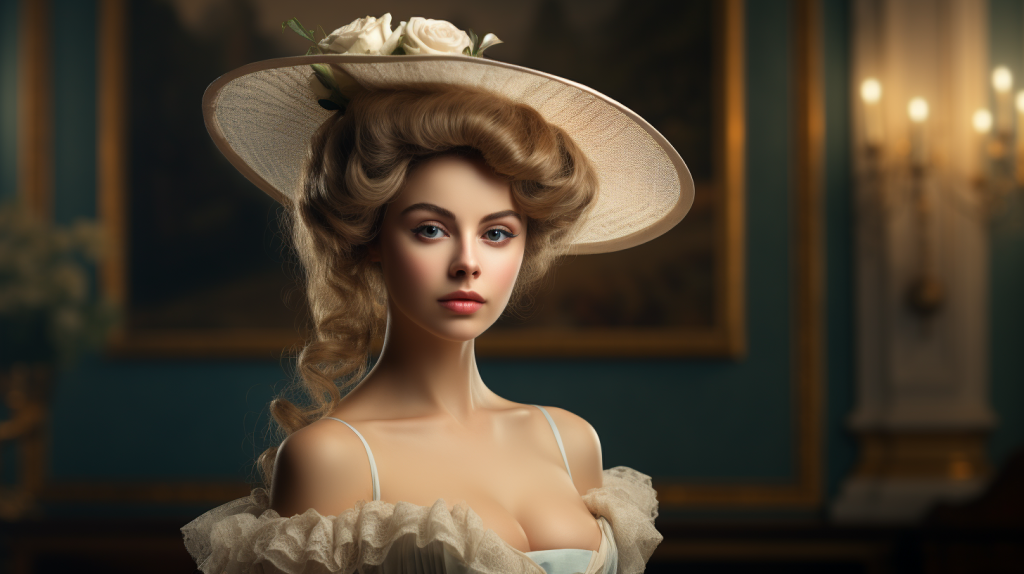
Hairpins: The Unsung Heroes of Victorian Coiffures
Venturing deeper into the realm of Victorian Hairstyles, we turn our attention to the modest yet pivotal elements of Victorian hair artistry: hairpins. Often overshadowed by more conspicuous fashion items, these simple accessories were foundational in crafting the elaborate hairstyles that epitomized Victorian elegance.
Hairpins in the Victorian era transcended their functional role, embodying a blend of personal style and social status. Crafted from materials as humble as wood and as lavish as gold and adorned with pearls or precious stones, these pins were as diverse as the women who wore them. For the affluent, a hairpin wasn’t just a tool but a statement piece, often becoming a canvas for exquisite craftsmanship.
The practicality of hairpins was indispensable. They were the linchpins that held together the complex hairstyles of the era. From anchoring braids to supporting additional hairpieces, hairpins were essential for maintaining the day-long integrity of these coiffures.
Beyond their utility, Victorian hairpins carried symbolic significance. They were often intimate gifts from suitors or cherished family items, laden with sentimental value. In the context of a hairstyle, a hairpin could represent a love story, a family legacy, or a personal milestone, weaving a narrative into every twist and turn of a braid.
Our exploration of hairpins unveils their diversity and importance in the Victorian era. These small items were not just tools of fashion; they were integral to the stories and identities of the women who wore them, anchoring the elaborate hairstyles that have captivated us through the ages.

Iconic Figures and Their Influence
As we weave through the tapestry of Victorian Hairstyles, it’s essential to spotlight the iconic figures of the era, whose influence on fashion and hairstyling was profound. These women, ranging from royalty to literary figures, were trendsetters, their choices in hairstyles often setting the standard for the rest of society.
Queen Victoria herself was a paragon of Victorian fashion. Her hairstyles, usually simple yet elegant, mirrored her position and the era’s values. The young queen initially favored uncomplicated styles, which later evolved into more mature, regal updos, reflecting both her personal growth and the changing times. Her influence extended beyond the borders of Britain, with women across Europe and America emulating her style.
Another influential figure was Alexandra, Princess of Wales, whose style was widely admired and imitated. She popularized the “Alexandra curl,” a hairstyle featuring a series of tight, graceful curls framing the face, a trend that became a hallmark of the era.
Literary icons like Jane Austen also contributed to the era’s hairstyle trends, although indirectly. Austen’s novels painted vivid pictures of the hairstyles and fashions of her time, influencing readers’ perceptions and aspirations regarding Victorian beauty standards.
Actresses and socialites of the era, like Lillie Langtry and Sarah Bernhardt, pushed the boundaries of conventional Victorian hairstyles, introducing more flamboyant and daring styles. Their public personas allowed them to experiment with hairstyles that were often ahead of their time, gradually influencing mainstream fashion.
These iconic women played a pivotal role in shaping the hair trends of the Victorian era. Their choices in hairstyles were not mere personal preferences but powerful statements that reflected and influenced societal norms and fashion trends. Their legacies continue to inspire and inform our understanding of Victorian fashion and culture.
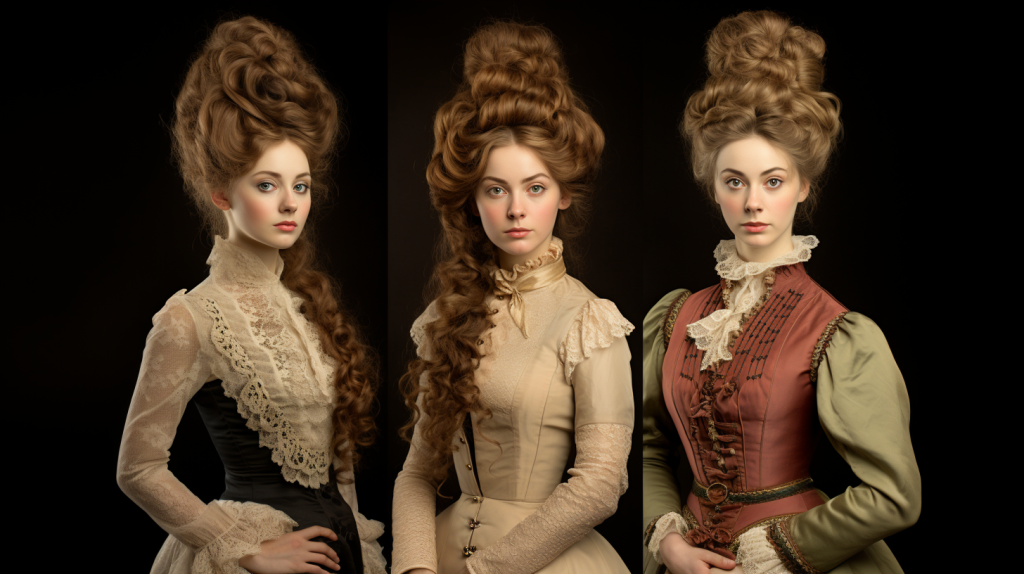
Victorian Hairstyles: A Cultural Reflection
The Victorian Hairstyles were more than mere trends; they were a vivid reflection of the cultural and artistic ethos of the era. Each twist, curl, and pin was a testament to the period’s intricate relationship between fashion, art, and societal shifts.
The Victorian era was a time of great artistic and cultural movements, each leaving its imprint on the fashion of the time. Romanticism, with its emphasis on emotion and individualism, influenced hairstyles to become more elaborate and expressive. This was evident in the voluminous updos and cascading curls that became popular, echoing the era’s fascination with drama and grandeur.
Similarly, the later Victorian fascination with the natural world, spurred by the scientific discoveries of the time, found its way into hairstyle trends. Floral motifs, natural hair colors, and styles mimicking the softness and flow of natural forms became popular, reflecting a shift towards a more organic aesthetic.
Hairstyles were also influenced by the technological advancements of the era. The advent of photography played a significant role in popularizing certain styles, as images of fashionable hairstyles could now be widely disseminated and emulated. Women were no longer limited to drawing inspiration from their immediate surroundings; they could now aspire to the styles worn by women in far-off lands.
Moreover, the global expansion of the British Empire brought exotic influences into Victorian fashion. Elements from colonized lands, seen as exotic and fashionable, were incorporated into hairstyles, sometimes in the form of accessories like combs and pins sourced from these regions.
Through this exploration, we see that Victorian hairstyles were not created in a vacuum. They were a canvas on which broader cultural and artistic movements were painted, a mirror reflecting the era’s complexities and contradictions. These hairstyles tell us stories about the Victorian era, about its people, their values, and their aspirations.
The Legacy of Victorian Hairstyles in Modern Fashion
As we near the end of our journey through Victorian Hairstyles, it’s essential to recognize how these styles have transcended time, leaving a lasting legacy in the world of modern fashion. The echoes of Victorian elegance and intricacy can still be felt today, as contemporary fashion frequently revisits and reinterprets these historic trends.
The resurgence of Victorian elements in today’s hairstyles is a testament to the era’s enduring influence. Modern updos, braids, and curls often draw inspiration from Victorian aesthetics, blending historical elegance with contemporary flair. Hairstylists and fashion designers continue to reference Victorian styles, finding new ways to weave historical elements into modern looks.
Moreover, the Victorian emphasis on personal adornment and the use of accessories like hairpins and ribbons has seen a revival. Today’s fashion often incorporates these elements, sometimes in a more minimalistic manner, as a nod to the intricate styling of the past.
The impact of Victorian hairstyles extends beyond just fashion; it’s evident in the arts and media as well. Period dramas and films often meticulously recreate these hairstyles, enchanting new generations with the beauty and complexity of Victorian fashion. Through these portrayals, the era’s hairstyles continue to capture imaginations, showcasing the timeless appeal of these elaborate coiffures.
In the world of high fashion, Victorian-inspired hairstyles frequently grace the runways, demonstrating the era’s influence on contemporary designers. These modern interpretations maintain the essence of Victorian elegance while infusing it with modern sensibilities, proving that the Victorian era’s fashion legacy is both adaptable and enduring.
Victorian era’s hairstyles were not just a fashion phenomenon of their time; they have become a lasting influence on modern styling. They remind us that fashion is cyclical, with each era drawing inspiration from the past to create something new and captivating.
As we draw the curtains on our exploration of Victorian Hairstyles, we step back from the looking glass of history, carrying with us a deeper understanding of how these intricate styles were more than just fashion statements. They were reflections of a complex era, a canvas upon which the tapestry of social, cultural, and artistic narratives were woven.
The Victorian era, with its strict societal norms and burgeoning artistic movements, found a unique expression in the hairstyles of its women. Each curl, braid, and hairpin was a stroke in the broader picture of an era defined by its contrasts and contradictions. These hairstyles tell stories of not just fashion trends but of women’s lives, their roles, and their silent yet eloquent expressions of beauty and identity.
As we witness the resurgence of these styles in modern fashion, it’s clear that the legacy of Victorian hairstyles is far from being just a relic of the past. They continue to inspire and influence, reminding us of a time when fashion was an intricate dance of elegance, modesty, and artistry. The Victorian hairstyles, in their elaborate twists and turns, are a testament to the timeless nature of beauty and the enduring allure of history.
In closing, our journey through the hairstyles of the Victorian era is not just a retrospective glance but a continuous conversation between the past and the present, between history and modernity. It’s a journey that celebrates the enduring charm and elegance of an era that continues to fascinate and inspire.



